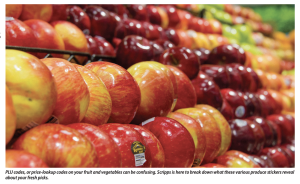Cracking the produce sticker code: What produce labels tell us about your vegetables and fruits
 When you reach for a piece of fruit or vegetable at the grocery store, you may notice a small sticker on the skin with numbers. These vegetable and fruit sticker numbers often have important information. The number is called a PLU code, or a price-lookup code. Unravel the mystery of fruit and vegetable code specifics and discover what these produce stickers reveal about your fresh picks. PLU codes have been used by supermarkets since the 1990s to help checkers identify fruits and vegetables so they can charge the correct price and maintain better inventory control. But the sticker is not just for checkout. “Food labels can tell you a lot about what you’re eating and help you make well-informed food choices for you and your family,” says Vikki Lane, MD, an internal medicine physician at Scripps Clinic Carmel Valley. HOW TO READ PLU CODES More than 1,400 PLU codes have been assigned to various types of fruits and vegetables. The International Federation for Produce Standards (IFPS) assigns these codes, which are optional. The four- or five-digit numbers identify the produce, indicating size, growing method, type of food (apple or orange for instance) and variety (such as a Honeycrisp or Golden Delicious apple).
When you reach for a piece of fruit or vegetable at the grocery store, you may notice a small sticker on the skin with numbers. These vegetable and fruit sticker numbers often have important information. The number is called a PLU code, or a price-lookup code. Unravel the mystery of fruit and vegetable code specifics and discover what these produce stickers reveal about your fresh picks. PLU codes have been used by supermarkets since the 1990s to help checkers identify fruits and vegetables so they can charge the correct price and maintain better inventory control. But the sticker is not just for checkout. “Food labels can tell you a lot about what you’re eating and help you make well-informed food choices for you and your family,” says Vikki Lane, MD, an internal medicine physician at Scripps Clinic Carmel Valley. HOW TO READ PLU CODES More than 1,400 PLU codes have been assigned to various types of fruits and vegetables. The International Federation for Produce Standards (IFPS) assigns these codes, which are optional. The four- or five-digit numbers identify the produce, indicating size, growing method, type of food (apple or orange for instance) and variety (such as a Honeycrisp or Golden Delicious apple).
The voluntary labels tell you whether you are purchasing organic or conventionally grown produce.
• Organically grown fruits and vegetables have labels with five digits starting with the number 9.
• Conventionally grown fruits and vegetables have labels with four digits.
• If the code contains more than five digits, it is not part of the internationally standardized system.
ORGANIC VS. CONVENTIONAL, WHAT’S THE DIFFERENCE?
Organically grown means natural fertilizers were used instead of synthetic chemicals. Organic farming uses compost and manure instead of chemical fertilizers. It uses insects and birds, and/or traps instead of synthetic pesticides. Crop rotation, mulching and hand weeding replace synthetic herbicides. Organic produce is usually grown without genetic engineering or modification. Conventionally grown means synthetic fertilizers and pesticides were used to promote growth and prevent disease. Produce can be called organic if it’s certified to have grown on soil that had no synthetic fertilizers and pesticides applied for three years prior to harvest, according to the federal Department of Agriculture (USDA). If you’re shopping on a budget, organic foods tend to be more expensive, due largely to limited supplies and additional labor and other costs to produce. 
You have options when buying conventionally grown produce, however. Just check which products have the lowest pesticide residue. The nonprofit Environmental Working Group (EWG) releases the annual Shopper’s Guide to Pesticides in Produce, which lists fruits and vegetables with the highest and lowest pesticide residues.
PLU CODES VS NUTRITION FACTS LABELS
PLU codes help cashiers charge customers correctly for different types of produce. They also help shoppers determine if the produce is organic or conventionally grown. To find out the nutrition information of fresh produce, you will need to do some research. The USDA maintains a nutritional value database for all kinds of foods. For packaged foods, you may also read the Nutritional Facts label on the back, bottom or side of the package. It provides detailed information about the nutritional content of the product, including serving size and calories.
“The more transparency we have in food labels the better,” says Dr. Lane. “With so many choices, understanding what labels, especially vegetable and fruit code specifics, mean can help clarify our food choices.
